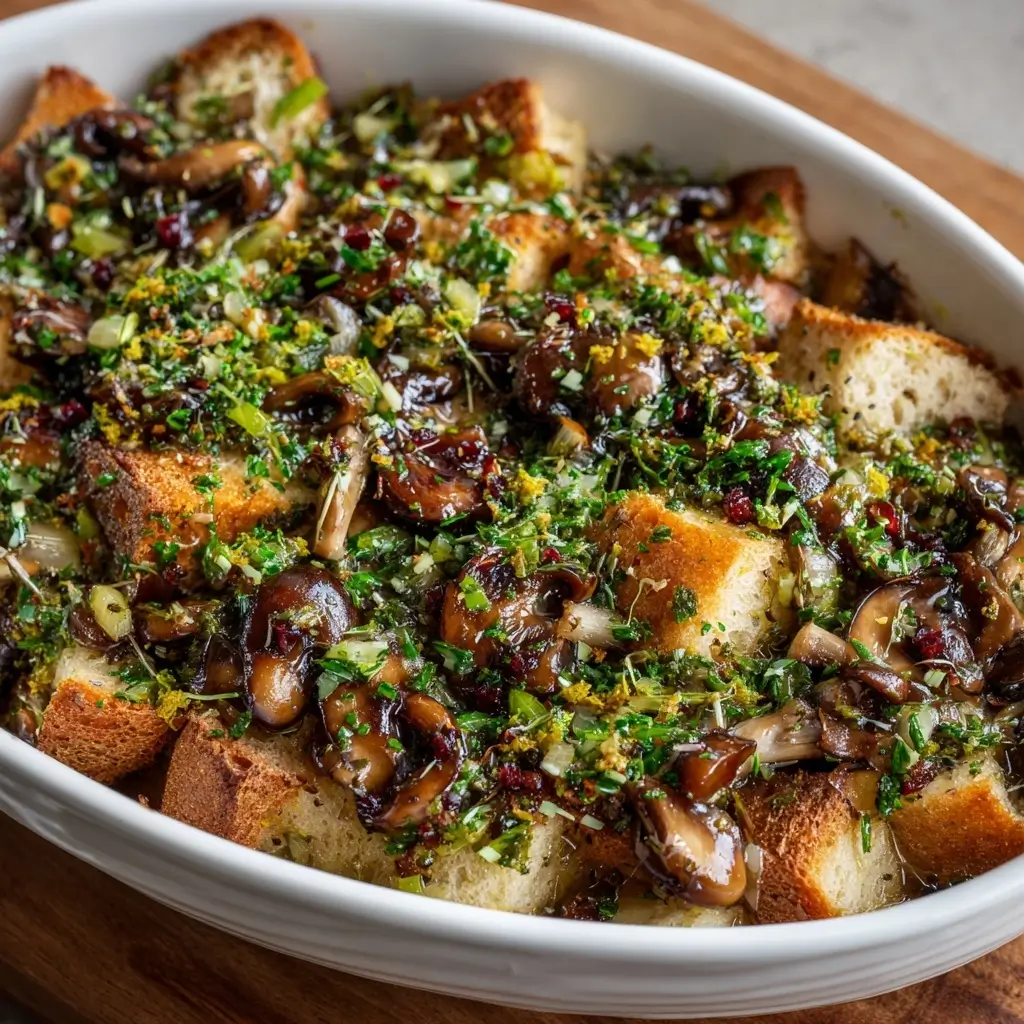Vegetarian Wild Mushroom Sourdough Dressing
Bring a rich, earthy depth to your holiday table with this luxurious Vegetarian Wild Mushroom Sourdough Dressing. Crafted from artisanal sourdough bread, an aromatic medley of wild mushrooms, and fragrant herbs, this dressing is a celebration of umami, texture, and comfort. Whether served as a centerpiece at Thanksgiving or as a cozy side dish during autumn gatherings, it elevates any meal with its savory complexity and satisfying heartiness—all while remaining entirely plant-based.
The History
Dressing, often confused with stuffing, has deep roots in culinary traditions across Europe and North America. Historically, the term “dressing” was used when the seasoned bread mixture was baked separately from the bird, while “stuffing” referred to being cooked inside poultry. In the American South, dressing has long been a staple at holiday feasts, traditionally made with cornbread or white bread and enriched with broth, onions, and herbs. Over time, regional variations have emerged—especially in vegetarian and gourmet adaptations. The use of sourdough reflects the growing appreciation for artisanal breads and fermented foods, while wild mushrooms introduce a foraged, forest-floor flavor reminiscent of European rustic cooking. This modern vegetarian version honors those traditions while embracing contemporary tastes, dietary preferences, and the increasing popularity of plant-forward cuisine.
Ingredients Breakdown
This recipe thrives on quality ingredients that work together to create layers of flavor and texture. Here’s a detailed look at each component:
- Sourdough Bread (12 oz, cubed and dried): The backbone of the dish. Sourdough’s tangy flavor and sturdy crumb absorb liquids beautifully without turning mushy. Day-old or slightly stale bread works best, helping reduce food waste.
- Wild Mushrooms (1 lb mixed: shiitake, oyster, cremini, chanterelle): These bring a deep umami richness. Each variety contributes unique textures and flavors—shiitake adds meatiness, oyster offers delicate frills, cremini brings earthiness, and chanterelles lend a fruity, apricot-like aroma.
- Unsalted Butter (4 tbsp) or Vegan Butter: Used to sauté aromatics and mushrooms, adding richness. For a fully plant-based version, high-quality vegan butter made from coconut or olive oil performs excellently.
- Olive Oil (2 tbsp): Complements butter and enhances the sear on mushrooms, contributing a fruity note.
- Yellow Onion (1 large, finely diced): Provides sweetness and foundational flavor when caramelized slowly.
- Celery (3 stalks, finely diced): Offers a crisp, slightly bitter contrast that balances the richness.
- Garlic (4 cloves, minced): Adds pungent depth; crucial for building savoriness.
- Fresh Thyme (2 tbsp chopped, plus sprigs for garnish): Earthy and slightly minty, thyme pairs perfectly with mushrooms and sourdough.
- Fresh Sage (2 tsp chopped): A quintessential herb in dressings, sage imparts a warm, peppery aroma that defines traditional flavor profiles.
- Fresh Rosemary (1 tsp chopped): Use sparingly—it’s potent. Adds piney notes that elevate the overall fragrance.
- Vegetable Broth (2½ cups, low-sodium preferred): The liquid base. Choose a high-quality brand or homemade for maximum flavor. Mushroom or roasted vegetable broths add extra depth.
- Dry White Wine (½ cup, optional): Deglazes the pan and introduces acidity and complexity. Substitute with additional broth if avoiding alcohol.
- Sea Salt (1½ to 2 tsp, to taste): Enhances all other flavors. Adjust based on broth saltiness.
- Black Pepper (1 tsp freshly ground): Adds warmth and subtle heat.
- Bay Leaf (1 whole): Simmered with the broth for background herbal nuance.
- Unsweetened Applesauce (¼ cup, optional): A secret ingredient! It tenderizes the bread and adds a hint of natural sweetness without detectable apple flavor.
- Toasted Pecans or Walnuts (½ cup, chopped, optional): For crunch and nutty richness—adds luxury and protein.
- Chopped Fresh Parsley (¼ cup, for garnish): Brightens the final dish with color and freshness.
Step-by-Step Recipe
- Prepare the Sourdough Cubes: Preheat oven to 300°F (150°C). Cut sourdough into ¾-inch cubes. Spread evenly on a large baking sheet. Bake for 45–60 minutes, tossing occasionally, until completely dry and crisp but not browned. Set aside to cool. (Alternatively, leave bread uncovered overnight at room temperature.)
- Sauté the Aromatics: In a large skillet or Dutch oven over medium heat, melt butter with olive oil. Add onions and celery. Cook slowly for 12–15 minutes, stirring occasionally, until soft and translucent (avoid browning). Stir in garlic, thyme, sage, and rosemary; cook for 1 minute until fragrant.
- Cook the Mushrooms: Increase heat to medium-high. Add mushrooms in batches if needed to avoid crowding. Sauté for 8–10 minutes until they release moisture and begin to caramelize. Season lightly with salt and pepper. If using wine, pour it in now, scraping up any browned bits, and simmer until reduced by half (about 3–4 minutes).
- Infuse the Broth: In a saucepan, warm vegetable broth with bay leaf over low heat for 10 minutes. Remove bay leaf before using. Keep warm.
- Combine Ingredients: In a very large mixing bowl, combine dried sourdough cubes, sautéed mushroom mixture, and applesauce (if using). Gently fold together. Gradually pour warm broth over the mixture, starting with 2 cups. Toss gently with a fork to moisten evenly. The bread should be well-saturated but not soggy. Add remaining ½ cup broth only if needed.
- Optional Add-ins: Fold in toasted nuts if using.
- Bake the Dressing: Transfer mixture to a greased 9×13-inch baking dish. Cover with foil and bake at 350°F (175°C) for 30 minutes. Uncover and bake for another 20–25 minutes until golden brown and crisp on top.
- Garnish and Serve: Let rest for 10 minutes. Sprinkle with fresh parsley and extra thyme sprigs before serving.
Tips
- Dry Bread is Key: Never skip drying the sourdough. Wet or fresh bread turns gummy. Stale bread absorbs liquid better and maintains structure.
- Don’t Rush the Sauté: Low and slow cooking of onions and celery builds sweetness and depth. High heat can burn them and create bitterness.
- Use a Mix of Mushrooms: Variety enhances flavor complexity. Avoid button mushrooms—they lack the depth of wild types.
- Warm Broth Matters: Cold broth cools the mixture and prevents even absorption. Warm broth helps hydrate the bread uniformly.
- Season in Layers: Salt each stage—mushrooms, vegetables, and final mix—to build balanced flavor.
- Avoid Overmixing: Once broth is added, handle gently to preserve bread texture.
- Make Ahead Option: Prepare through step 5 one day in advance. Refrigerate covered. Bring to room temperature before baking. Add 5–10 minutes to covered baking time if cold.
- Crispy Top Tip: For extra crunch, broil for 2–3 minutes at the end—watch closely to prevent burning.
Variations and Customizations
- Gluten-Free Version: Substitute sourdough with gluten-free artisan bread or a blend of gluten-free cornbread and rice. Dry thoroughly to maintain texture.
- Vegan Upgrade: Use vegan butter and ensure broth is certified plant-based. Nutritional yeast (2–3 tbsp) can boost umami and add a cheesy note.
- Herb Variations: Try tarragon for a French twist, marjoram for floral notes, or dill for brightness. Adjust quantities to avoid overpowering.
- Add Dried Fruit: Incorporate ⅓ cup rehydrated dried cherries, cranberries, or golden raisins for sweet-tart contrast.
- Spice It Up: Add a pinch of red pepper flakes or smoked paprika for warmth and depth.
- Cheesy Twist (Lacto-Ovo Option): Fold in ½ cup grated Parmesan, Pecorino, or sharp cheddar before baking for a richer profile.
- Grain-Enhanced: Mix in 1 cup cooked wild rice, farro, or quinoa for added chew and nutrition.
- Smoky Flavor: Add 1 tsp smoked sea salt or ½ tsp liquid smoke for a campfire-like essence.
- Holiday Style: Add candied pecans, orange zest, and a splash of Grand Marnier for festive flair.
Health Considerations and Nutritional Value
This vegetarian dressing is more than just delicious—it can be part of a balanced diet when enjoyed mindfully. Here’s what you need to know:
- Low in Saturated Fat: When made with minimal butter or vegan alternatives, it remains heart-friendly. Olive oil contributes healthy monounsaturated fats.
- Rich in Fiber: Sourdough, especially whole grain versions, provides complex carbohydrates and fiber. Mushrooms and vegetables add insoluble fiber, supporting digestive health.
- Umami Without Meat: Wild mushrooms are naturally high in glutamates, giving that satisfying savory taste without animal products—ideal for plant-based diets.
- Packed with Antioxidants: Mushrooms contain selenium, ergothioneine, and polyphenols—compounds linked to reduced inflammation and immune support.
- Herbs for Health: Thyme and sage have antimicrobial and anti-inflammatory properties. Rosemary contains rosmarinic acid, known for its antioxidant effects.
- Watch Sodium: Use low-sodium broth and control added salt to manage blood pressure. You can also enhance flavor with lemon zest or nutritional yeast instead of salt.
- Portion Control: While hearty, this dish is calorie-dense due to bread and fat content. A ¾-cup serving is satisfying and nutrient-balanced.
- Allergen Notes: Contains gluten (from sourdough). For nut allergies, omit pecans/walnuts. Ensure vegan butter is nut-free if required.
Nutritional Estimate (per ¾ cup serving, without nuts or cheese):
Calories: 180 | Carbohydrates: 28g | Protein: 5g | Fat: 6g (Saturated: 3g) | Fiber: 3g | Sugar: 4g | Sodium: 350mg | Iron: 1.8mg | Vitamin D: 0% DV | Calcium: 2% DV
Ingredients
- 12 oz sourdough bread, cut into ¾-inch cubes
- 4 tbsp unsalted butter or vegan butter
- 2 tbsp olive oil
- 1 large yellow onion, finely diced
- 3 celery stalks, finely diced
- 4 garlic cloves, minced
- 1 lb mixed wild mushrooms (shiitake, oyster, cremini, chanterelle), cleaned and sliced
- 2 tbsp fresh thyme, chopped (plus extra for garnish)
- 2 tsp fresh sage, chopped
- 1 tsp fresh rosemary, chopped
- 2½ cups vegetable broth (low-sodium)
- ½ cup dry white wine (optional)
- 1 bay leaf
- 1½ to 2 tsp sea salt (to taste)
- 1 tsp freshly ground black pepper
- ¼ cup unsweetened applesauce (optional)
- ½ cup toasted pecans or walnuts, chopped (optional)
- ¼ cup fresh parsley, chopped (for garnish)
Directions
- Preheat oven to 300°F. Spread sourdough cubes on a baking sheet and bake for 45–60 minutes, tossing occasionally, until dry and crisp. Set aside to cool.
- In a large skillet or Dutch oven, heat butter and olive oil over medium heat. Add onion and celery; cook 12–15 minutes until soft.
- Stir in garlic, thyme, sage, and rosemary; cook 1 minute until fragrant.
- Increase heat to medium-high. Add mushrooms and sauté 8–10 minutes until browned and tender. If using wine, add and reduce by half.
- Warm broth with bay leaf in a saucepan for 10 minutes. Discard bay leaf.
- In a large bowl, combine sourdough, mushroom mixture, and applesauce. Gradually pour in warm broth, starting with 2 cups. Toss gently to combine.
- Fold in toasted nuts if desired.
- Transfer to a greased 9×13-inch baking dish. Cover with foil and bake at 350°F for 30 minutes.
- Uncover and bake 20–25 minutes more until golden and crisp on top.
- Let rest 10 minutes. Garnish with parsley and serve warm.
FAQ
Can I make this ahead of time?
Yes! Assemble the dressing (without baking) up to one day in advance. Cover and refrigerate. Let sit at room temperature for 30 minutes before baking. Add 5–10 minutes to the covered baking time if starting cold.
Can I freeze vegetarian wild mushroom sourdough dressing?
Absolutely. Cool completely, then wrap tightly and freeze for up to 3 months. Thaw in the refrigerator overnight. Reheat in a 325°F oven, covered, for 30–40 minutes, then uncover to crisp the top.
Why is my dressing too soggy?
This usually happens if the bread wasn’t dried enough or too much broth was added. Always start with less liquid—you can always add more. Also, avoid covering during the last 20 minutes to allow moisture to escape.
Can I use regular mushrooms?
You can, but wild varieties offer superior flavor and texture. If using button or portobello mushrooms, boost umami with 1 tbsp soy sauce or tamari added with the broth.
Is sourdough necessary?
While other breads work, sourdough’s density and tang make it ideal. Avoid soft sandwich bread, which disintegrates easily.
How do I store leftovers?
Cool completely, then refrigerate in an airtight container for up to 5 days. Reheat in the oven or toaster oven to retain crispness—microwaving makes it rubbery.
Can I make this on the stovetop?
Yes, though texture may differ. After combining ingredients, transfer to a greased skillet, cover, and cook over low heat for 20–25 minutes, pressing down and checking occasionally for doneness.
Summary
A rich, umami-packed Vegetarian Wild Mushroom Sourdough Dressing that celebrates earthy mushrooms, tangy sourdough, and fragrant herbs—perfect for holiday feasts or elegant dinners. Fully plant-based, customizable, and deeply satisfying, this dish proves that vegetarian comfort food can be both luxurious and nourishing.










